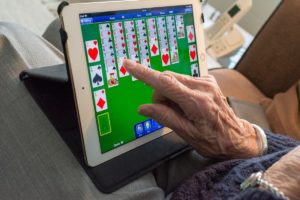A pilot program in South Carolina is addressing the digital divide by teaching seniors in rural counties how to use telehealth technology.
By Eric Wicklund
July 26, 2021 – A pilot program in South Carolina is tackling the digital literacy divide with a program that teaches seniors how to use telehealth technology.
Supported by the South Carolina Department on Aging and the national non-profit Rural Local Initiatives Support Corporation (Rural LISC), the program equips seniors in rural communities with a tablet and free cellular service for up to a year. The seniors attend classes on digital literacy at local community centers, building a comfort level with devices that are fast becoming a portal to connected health in underserved communities.
“It is our hope that this pilot program will be a model of one approach to closing the digital divide in South Carolina,” Kathy Schwarting, CEO of Palmetto Care Connections (PCC), told the South Carolina-based Statehouse Report.
PCC, a state-wide non-profit connected health organization that co-chairs the South Carolina Telehealth Alliance with the Medical University of South Carolina (MUSC), conducted the program, which involved roughly 100 seniors in rural Barnwell and Allendale counties. The pilot program will expand to three more counties soon, with hopes of becoming statewide.
“They loved it,” Schwarting said of the seniors, who learned how to use tablets not only for virtual visits with their care providers but also for communicating with family and friends, playing games and accessing other online resources.
Digital literacy – or a lack thereof – is considered a social determinant of health, and a considerable barrier to telehealth adoption in rural and remote parts of the country. People won’t use telehealth if they’re not comfortable with the technology, and if they can’t afford or access it easily, they have little opportunity to become familiar with it.
The shift to telehealth during the coronavirus pandemic cast the digital literacy gap in a harsh light, and prompted healthcare organizations and telehealth advocates – including the American Medical Association and the Telehealth Equity Coalition, launched this past February – to study how to address that gap.
“With the pandemic we’re creating a bigger digital divide,” says Luis Belen, CEO of the National Health IT Collaborative for the Underserved (NHIT), a public-private partnership launched in 2008 to engage underserved populations in the use of health information technology. “We need to start having conversations that focus on creating equity.”
Another health system tackling the divide is Jefferson Health. After receiving funding last year to expand its telehealth network to address COVID-19, the Philadelphia-based network created a task force to make sure those expanded resources would be used.
“You can’t just hand someone a device and expect they’re going to be on a telehealth visit the next day,” said Kristin Rising, MD, MS, an associate professor and director of the Center for Connected Care. “Many people aren’t comfortable using telehealth. You have to find out why … and help them.”
“Telehealth has the potential to decrease our digital divide,” she added. “But we need to know how to use it first.”
Source: mHealth Intelligence


 The accomplishments of the program promise change for the state, Schwarting said.
The accomplishments of the program promise change for the state, Schwarting said.



